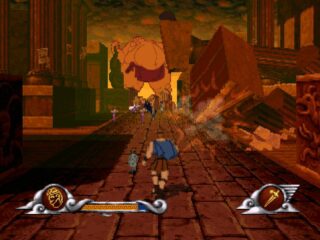Disney's Toy Story is a side-scrolling platformer developed by Traveller's Tales and released in 1995 for SNES and Genesis. The game is based on Pixar's groundbreaking animated film. This adaptation represents an example of how movie tie-in games could successfully translate cinematic storytelling into interactive gameplay, drawing inspiration from established platformers like Earthworm Jim while creating its own distinct identity within the crowded 16-bit landscape.
The game follows the film's narrative structure closely, allowing players to experience key moments from both Woody's and Buzz Lightyear's perspectives across multiple gameplay styles. Rather than creating a generic run-and-jump platformer, Traveller's Tales crafted varied gameplay mechanics that reflect each character's unique abilities and personality. Woody levels emphasize his cowboy heritage with lasso-swinging mechanics reminiscent of Bionic Commando, requiring players to master rope physics and timing to navigate vertical challenges and reach distant platforms.
Buzz Lightyear's segments showcase his space ranger delusions through pseudo-3D flying sequences that break away from traditional side-scrolling conventions. These sections feel like simplified versions of Star Fox or Space Harrier, with Buzz soaring through Andy's house and neighborhood while avoiding obstacles and collecting power-ups. The contrast between Woody's grounded, methodical platforming and Buzz's high-speed aerial gameplay creates variety that prevents the experience from becoming monotonous.
Level design demonstrates remarkable creativity in translating domestic environments into platforming challenges. Andy's room becomes a sprawling playground where everyday objects transform into gameplay elements - books serve as moving platforms, toy cars provide transportation, and household items create both obstacles and tools. The famous moving truck sequence captures the film's climactic chase with scrolling mechanics that demand quick reflexes and precise jumping.
Visually, both versions showcase impressive sprite work that translate the 3D models of the film into 2D pixel art. Character expressions and animations reflect the voice acting performances, with Woody's determined swagger and Buzz's confident posturing translating effectively into pixel form.
The audio presentation varies significantly between platforms, with the SNES version featuring higher-quality samples of Randy Newman's memorable score and selected voice clips from the film's cast. The Genesis version, while lacking some audio fidelity, maintains the musical themes effectively and provides satisfying sound effects that complement the action. Both versions succeed in creating an authentic Toy Story atmosphere that reinforces the connection to the source material.
Gameplay mechanics extend beyond simple jumping and attacking, incorporating puzzle elements and exploration that reward careful observation. Hidden areas contain collectible items that unlock bonus content, while secret passages reference obscure details from the film that will delight fans. The difficulty curve accommodates younger players without completely abandoning challenge, though some later levels demand genuine platforming skill that might frustrate the target demographic.
The game's greatest strength lies in its understanding that successful movie adaptations must function as games first and promotional material second. Traveller's Tales created mechanics that feel natural within the Toy Story universe while providing gameplay depth that extends beyond the film's runtime. The result is a platformer that works both as an interactive companion to the movie and as a standalone gaming experience that can be enjoyed by players unfamiliar with the source material.
For platforming enthusiasts and Disney fans alike, this represents one of the more successful movie tie-in games of the 16-bit era, proving that licensed properties could produce genuinely entertaining interactive experiences when developed with care and creativity.














